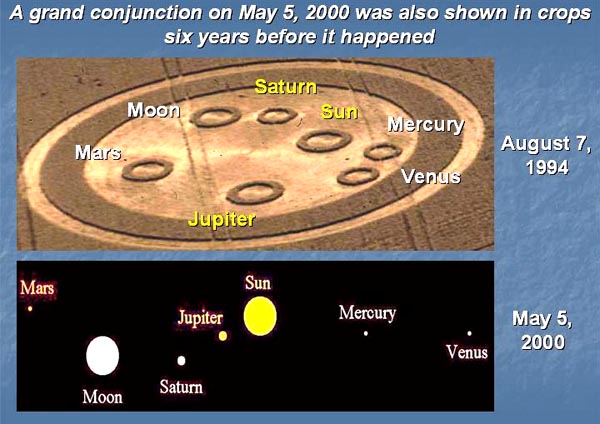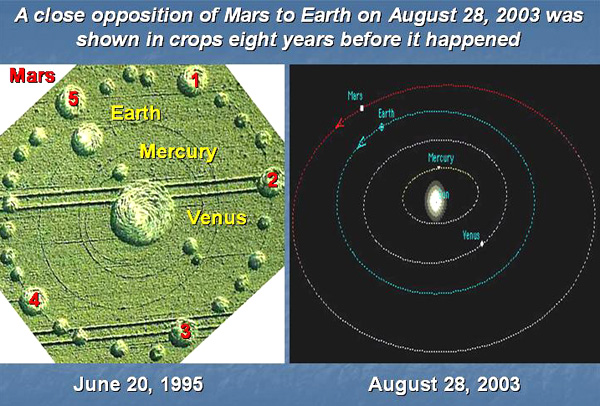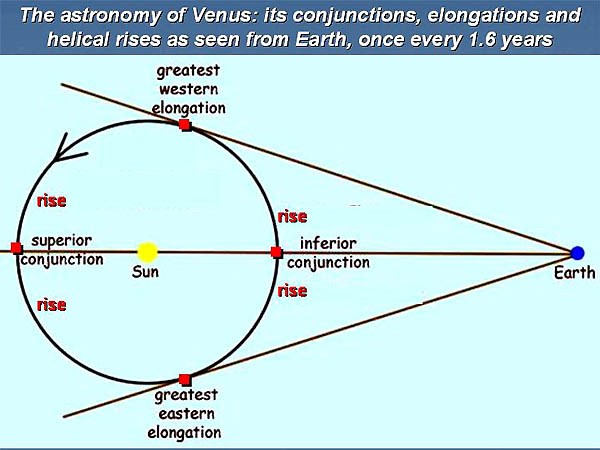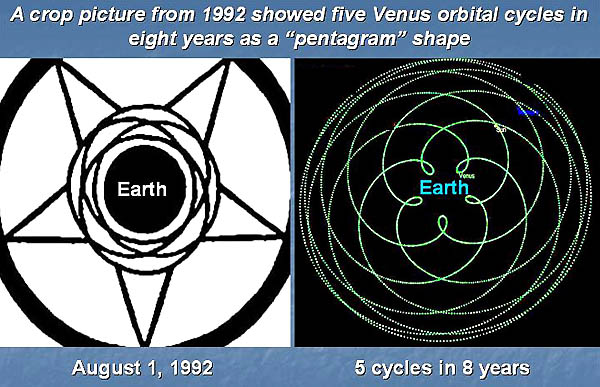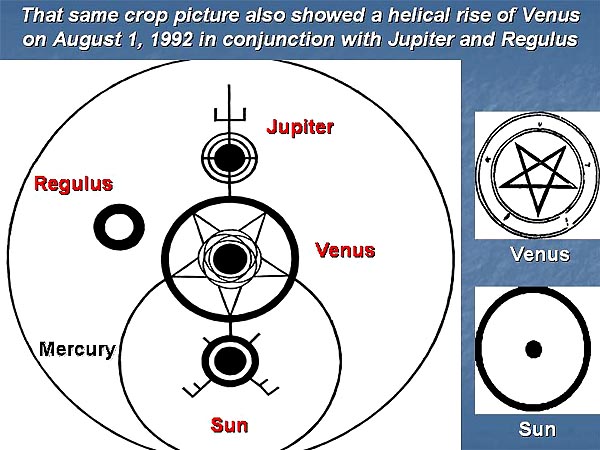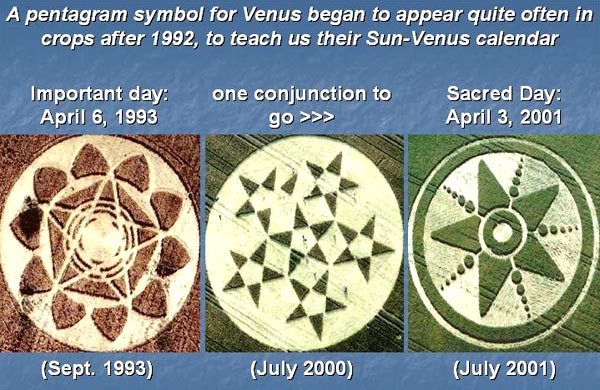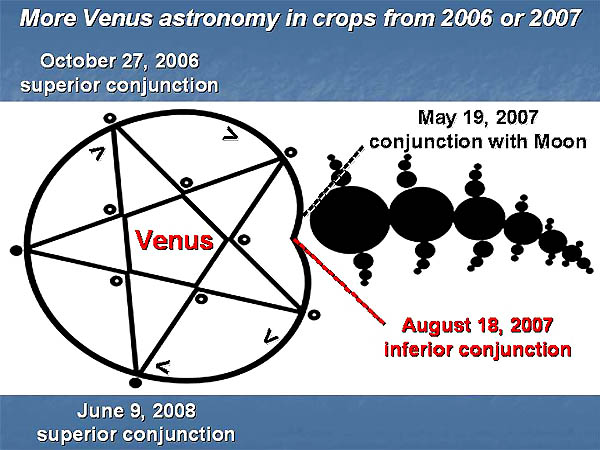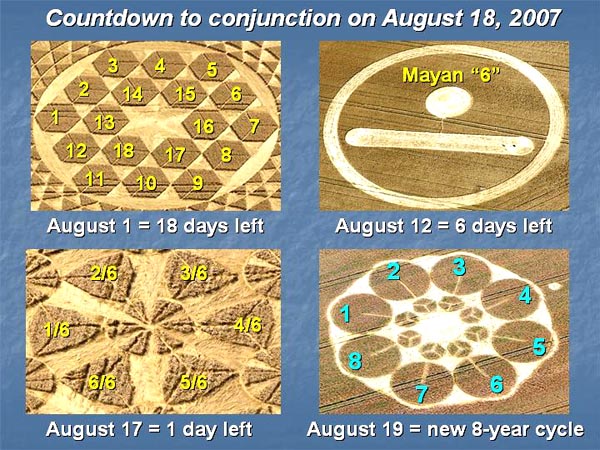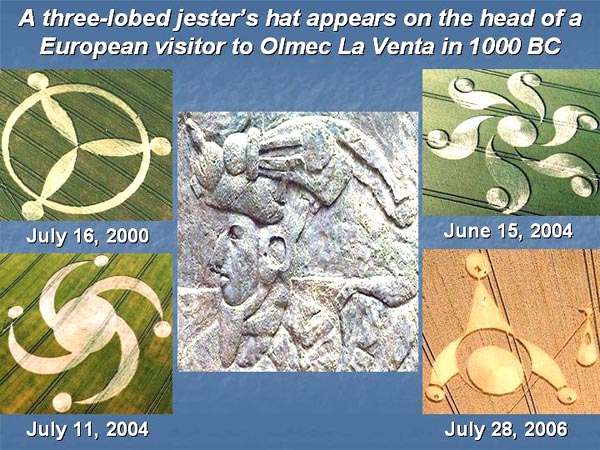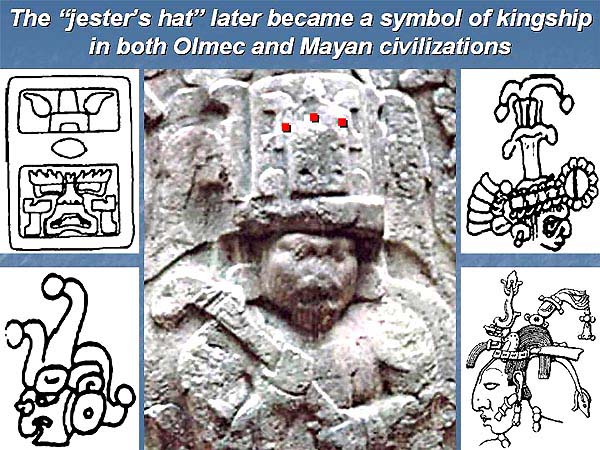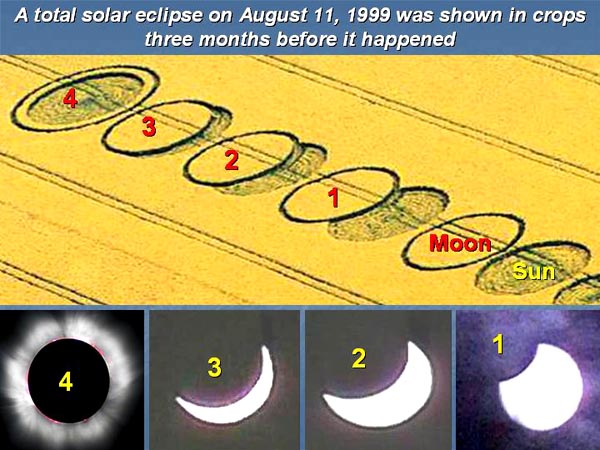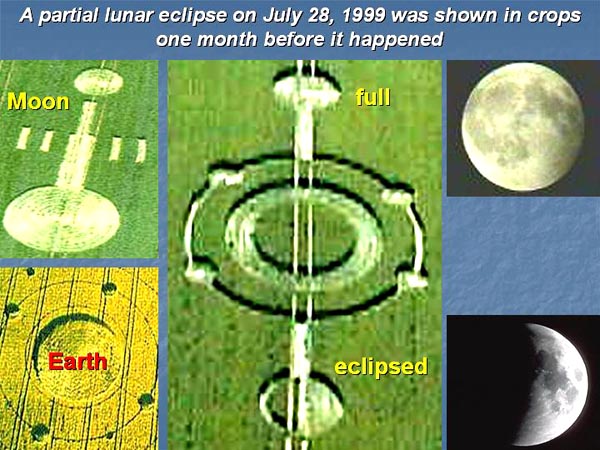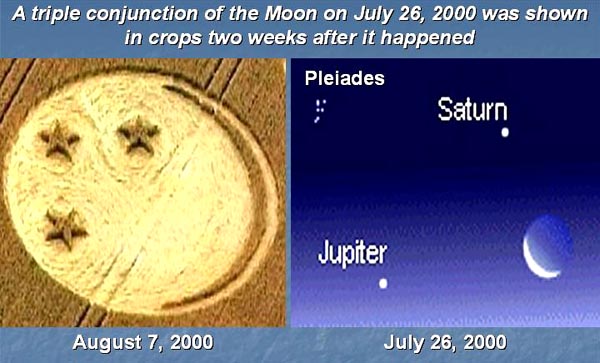|
A Mayan calendar, the Jester's Hat and eclipses: who else but Quetzalcoatl? In two previous essays on this website, I explored how the modern crop-picture phenomenon seems to be based on an ancient Sun-Venus calendar that was in regular use thousands of years ago, mainly in central America. Today we know about it mostly from the famous Dresden Codex, which was one of the few Aztec-Mayan literary works to survive a systematic destruction of their culture in 1520, after European invasion. What else might they have known that we have since forgotten? Here I will explore first how planetary astronomy shows a long and well-documented history in modern crop pictures, dating back to the inception of this phenomenon in Wiltshire1988-1992. Then I will show how some crop pictures seem to match a reconstruction of the ancient Sun-Venus calendar for our modern era (by John Major Jenkins). Next I will investigate unexpected links of this crop-picture phenomenon to the Jester's Hat symbolism of Olmec-Mayan kings, which seems to be some kind of "cargo cult" inspired by Quetzalcoatl (a long-nosed, fancy-dressing Englishman). Finally I will show how certain modern crop pictures seem to mark solar or lunar eclipses, in a fashion further consistent with Olmec-Mayan astronomy. All measures of this strange phenomenon seem to indicate that we are receiving messages from the distant past, or from some modern culture that possesses a great deal of the advanced knowledge that was present on Earth long ago; rather than from any kind of extra-terrestrial visitors from an alien world. A long history of planetary astronomy in crops The crop picture phenomenon has always concerned itself with planetary astronomy. Some of the best early analyses were produced by Jack Sullivan and Andy Thomas on www.swirlednews.com/article.asp?artID=659 or
www.cropcircleconnector.com/Cetus/Cetus200.html.
Because those early crop pictures seem relevant to later ones
that I will discuss below, we ought to review them briefly here.
"A rare and beautiful sight awaits sky-watchers this evening. The three brightest outer planets, Jupiter, Saturn, and Mars, plus a two-day-old crescent Moon, will produce a striking arrangement on the western horizon at dusk. Saturn will lie 3 degrees above the Moon, Jupiter the brightest will lie 6 degrees lower right of Saturn, while Mars will lie 1 degree upper right of Jupiter." An auroral shock wave also passed through Earth on April 6, 2000 (http://science.nasa.gov/headlines/y2000/ast07jun_1m.htm). See the
websites listed above for a match of the many "small filled
circles" in that crop picture to stars in the constellation
Cetus. Its three "large open circles" were clearly intended to
represent planets. Jupiter and Saturn conjunct once every 20
years, but seldom in Cetus. Mars was located close to Jupiter
(as seen from Earth) on April 6. Then it passed halfway between
Jupiter and Saturn on April 11. Finally it was located between
Saturn and the Moon on April 16. The sky photo shown in our
diagram above was taken on April 6.
The time difference between crop pictures from Avebury or Froxfield equals 16 days (July 22 to August 7, 1994). Six years later, the time difference between sky events that they symbolize equalled 30 days (April 6 to May 5, 2000). Jack Sullivan argued that this Froxfield picture might be explained by a match to other stars in Cetus, yet its large open circles indicate planets rather than stars. June 20, 1995 at Gander Down: four planets Mars, Earth, Mercury and Venus appear in their precise orbital locations for eight years later on August 28, 2003, when Mars and Earth would come historically close at opposition:
In order to understand this picture in greater detail, first we have to learn something about Venus astronomy. Venus orbits the Sun as seen from Earth once every 584 days or 1.6 years. During each orbital period, it shows an "inferior conjunction" (between Sun and Earth), a "superior conjunction" (opposite Sun from Earth), and two "elongations" (far from the Sun as seen from Earth): .
Furthermore, during any conjunction (whether inferior or superior), Venus also shows certain periods of invisibility, when the Sun's nearby glare prevents it from being seen clearly. Just after each of those periods, the astronomy of Venus features what is known as a "helical rise", when Venus finally gets far enough away from the Sun to be seen on Earth. Now back to the crop picture! Five different "large circles" were shown there for the orbit of Mars (see above). Large circle "5" clearly represents the date of its closest approach to Earth on August 28, 2003. But what about the other four? We can assign dates to the other four by noting that the orbital period of Venus at 584 days (as seen from Earth) is somewhat less than the orbital period of Mars at 780 days. Thus Mars will advance in its orbit as seen from Earth by only (584 / 780) x 360 = 270 degrees, for every time that Venus completes a full cycle of 360 degrees. Indeed, large circle "4" in that crop picture lags behind circle "5" by 90 degrees, so it may be assigned to a conjunction of Venus on January 14, 2002, that happened 584 days before August 18, 2003. Similarly, large circle "3" lags behind "4" by 90 degrees, and should match June 11, 2000 which happened 584 days before January 14, 2002. Large circle "2" lags 90 degrees behind "3" and should match October 30, 1998, while large circle "1" lags 90 degrees behind "2" and should match April 2, 1997. This would seem to be one of the earliest examples where those crop artists used conjunctions of Venus with our Sun to date events in our modern world. Venus astronomy
had begun to appear in Wiltshire crops by 1992
August 1, 1992 at Canford: a whole series of planetary symbols were shown there, to be explained below. One was the ancient and well-known pentagram symbol for Venus:
Close to the centre of that pentagram, we can see a series of overlapping circles that match precisely the spiral orbit of Venus as seen from Earth. It completes five orbital cycles in eight solar years, with only two days off as 2920 rather than 2922. Now looking at the entire crop picture from Canford, we can assign all of its planetary symbols by comparing with known events in Earth's sky on a similar date:
Venus passed behind the Sun (superior conjunction) on June 13, 1992. Then it re-appeared in the evening sky (a helical rise) in early August when that crop picture appeared. Next it came to within 1.1 degrees of the star Regulus on August 6, then came very close to Jupiter on August 22. Two weeks later on September 16, Jupiter conjuncted with Mercury. Their five astronomical symbols for "Sun, Venus, Regulus, Jupiter and Mercury" may therefore be assigned through simple one-to-one logic. Regulus as a unstructured star was shown as an "open circle". Mercury was shown by its familiar "two winged" symbol, indicating great speed. Jupiter, king of the planets, was shown by a "three-pronged trident". A reconstruction
of the ancient Sun-Venus calendar for modern times
Jenkins argues that the inferior conjunction of Venus on April 1, 1993 was one important event, followed by its helical rise on April 6, 1993. He furthermore argues that second inferior conjunction on March 30, 2001 was another important event, followed by another helical rise or "Sacred Day" on April 3, 2001. Both of those days from our modern Sun-Venus calendar were marked by pentagram crop pictures symbolizing Venus (left and right below):
A third crop picture (centre) implied that, prior to a Sacred Day on April 3, 2001, only one Venus conjunction from five cycles remained as of July 2000. I have listed below a series of important Venus conjunctions from their modern calendar, which began on April 10, 1961 and will end on March 28, 2013. Table I. Some conjunctions of Venus with the Sun in our modern era (1961-2013 AD) Modern date
Venus-Sun alignment Calendar significance Conjunctions
after March 30, 2001 After 2001, more Venus astronomy continued to appear in crops during 2002 and 2003. Two examples are shown below for an elongation of Venus on August 22, 2002, or a superior conjunction of Venus on August 18, 2003 (as also symbolized at Gander Down in 1995):
More Venus astronomy in crops from 2006 and 2007 After 2002 and 2003, we saw the famous "Mayan Sunstone" pictures at Silbury Hill 2004 or Wayland's Smithy 2005. Both of those used a Sun-Venus calendar to date modern events. Then in 2006 and 2007, we saw even more pictures involving Venus, one of which illustrated quite clearly a conjunction of Venus with our Moon on May 19, 2007:
The red letters in that diagram above mark an inferior conjunction of Venus with the Sun on August 18, 2007. That date turned out to be of unexpected importance, because the crop artists decided to mark its significance through a series of four other crop pictures just before the event. Three of those used symbols from sacred geometry, while the fourth was Olmec-Mayan. A countdown to conjunction on August 18, 2007 As shown in the diagram below, those crop artists conducted a numerical countdown to conjunction of Venus with the Sun on August 18, 2007 by showing symbols for the number "18" on August 1, "6" on August 12, or "1" on August 17:
One day after conjunction on August 19, they next showed symbols for the number "8", to emphasize that a new eight-year cycle of Venus had begun. Their first picture on August 1 used 18 cubes from "Metatron's Cube" to make their point. Their next picture on August 12 used an Olmec-Mayan symbol for "six". A third picture on August 17 used six "sliced cubes" of one-sixth normal volume in a "Flower of Life" arrangement, to signify 6 x 1/6 = 1 day. A fourth picture on August 19 used the eight cubes which make up any four-dimensional cube or "tesseract" to symbolize a new eight-year cycle of Venus. The Jester's Hat: who else but Quetzalcoatl as a fancy-dressing, long-nosed Englishman? Who could be responsible for all of this intellectual chicanery? Certainly some ancient scholar with a great sense of humour! Our most specific clue to the origin of this strange phenomenon may come from a series of Jester's Hat crop pictures that have appeared over the years. June 3, 2002 at Sompting: "This morning we woke to find a crop circle in the field at the bottom of our road, just north of the A27 at the bottom of Halewick Lane, Sompting. My father Bob Parsons took the photo shown below."---Maxine Ross and Paul Parsons.
"On the night that crop formation appeared, a local boy aged 10 reported being woken at 1 AM by a bright light coming through his curtains. Looking out, he saw a light coming from above the field. His sister was also woken and, once alert, peered out and saw the same light. It lasted for two to three minutes, then went out abruptly. They found the experience frightening." Not only at Sompting, but in four other diverse places or years, have those humorous Jester's Hat crop pictures appeared:
In the last one from July 28, 2006 at East Field, we can even see a "stick and knapsack" that gives the impression of "travelling". Now of all the people who became famous in ancient times for wearing a jester's hat, and had some kind of association with central America, whom would we place at the top of our list? None other than Quetzalcoatl, a long-nosed, fancy-dressing Englishman! See above his statuary from Olmec.La Venta, dating to1000 or 500 BC. That was not his real name, but only a humorous nickname that the Olmecs had given him. It translates to "quetzal" (brightly-coloured bird) and "coatl" (serpent or wise). A Jester's Hat later became the symbol of Mayan kings, in honour of his memory as a great and wise teacher:
May 3, 1999 at Wallop: a series of overlapping circles showed the classic appearance of a solar eclipse, where a dark Moon comes between Earth and the bright Sun in several stages. In fact, there was a total solar eclipse all across Europe just three months later on August 11, 1999:
June 23, 1999 Stanton St. Bernard: the usual crop artist symbol for "Earth" was shown between two full-white or half-white symbols for "Moon", suggestive of a lunar eclipse where Earth comes between Sun and Moon. In fact, there was a partial lunar eclipse just one month later on July 28, 1999:
August 7, 2000 Pewsey: three stars were shown close in the sky to a crescent Moon. In fact, there was a lunar conjunction with Jupiter, Saturn and the Pleiades just two weeks earlier on July 26, 2000, which matches the crop geometry exactly:
If humans today
could send messages forward in time from 2000 AD to 6000 AD,
what would we say? Their knowledge of English might even be quite rudimentary: see for example a stilted message given in ASCII-English that appeared at Crabwood on August 15,1992. Yet we can hardly blame them for not speaking English, because we cannot read their written language either! Many hieroglyphs appeared in crops at Wiltshire during 1990 or 1991, but still remain uninterpretable to us. If humans today could send messages into the future, say from 2000 AD to 6000 AD, what would we say? Would we talk about "Big Brother", English football or "Dancing With the Stars"? Or would we send more lasting, universal messages like those which Carl Sagan sent from Arecibo? The crop artist
technology seems to involve space-time wormholes rather than
extra-terrestrial spacecraft Well, those crop artists have repeatedly shown pictures of space-time wormholes, rather than of spacecraft. They said explicitly at Crabwood that their message had been sent through a space-time "conduit". November 2007 lies halfway between August 2002 and March 2013, and marks an alignment of Jupiter with the galactic centre Another part of the message at Crabwood said "much pain but still time". That picture appeared on August 15, 2002, while their Sun-Venus calendar will end on March 28, 2013. Could "much time" be ten years? At Wayland's Smithy in 2005, one set of hexadecimal numbers gave the date when that crop picture appeared (August 9, 2005), while the other set gave November 21, 2007, which lies halfway between August 2002 (Crabwood) and March 2013 (end of their calendar). November 21, 2007 will also mark an approximate alignment of Jupiter with our galactic centre (as seen from Earth), just as the winter solstice of 2012 (or any year) will mark an alignment of our Sun with the galactic centre. Whether these particular alignments are simply calendrical, or have some other physical meaning, remains to be determined.
Red Collie (a scientist like the
crop artists, yet living far ahead of them in time)
|

